Comparison of H2O Adsorption and Dissociation Behaviors on Rutile (110) and Anatase (101) Surfaces Based on ReaxFF Molecular Dynamics Simulation
Abstract
:1. Introduction
2. Results and Discussion
2.1. Adsorption and Dissociation Mechanism of H2O on Rutile (110)
2.2. Adsorption and Dissociation Mechanism of H2O on Anatase (101)
2.3. The Roles of the H-Bond Network in Water Dissociation
3. Methods
4. Conclusions
- (1)
- There is a mixed adsorption trend with both molecular and dissociative adsorption on the rutile (110) surface. Compared with that on the rutile (110) surface, molecular adsorption is dominant on the anatase (101) surface.
- (2)
- The dissociation of H2O is mainly the direct dissociation on the rutile (110) surface. The interfacial H-bond between the adsorbed H2Oad molecule and the surface Obr promotes proton transfer for H2O dissociation on the rutile (110) surface. Compared with that on the rutile (110) surface, the dissociation of H2O is dominated by indirect proton transfer on the anatase (101) surface. This different catalytic function is solely determined by the distance between Ti5c and Obr on the surface, which determines the behavior of water dissociation.
- (3)
- The H-bond network plays a crucial role in the dissociation of H2O on rutile (110) and anatase (101) surfaces. At high coverage (>1.5 ML), the H-bond network structure of the second layer of water on the rutile (110) surface inhibits the dissociation of H2O to some extent. Compared with that on the rutile (110) surface, the RMD simulation shows that H-bond could assist the proton transfer on the anatase (101) surface. In an aqueous environment, the dissociation of H2Oad is promoted by the enhanced H-bond network structure of the second layer of water on the anatase (101) surface.
Supplementary Materials
Author Contributions
Funding
Institutional Review Board Statement
Informed Consent Statement
Data Availability Statement
Conflicts of Interest
Sample Availability
References
- Wagstaffe, M.; Dominguez-Castro, A.; Wenthaus, L.; Palutke, S.; Kutnyakhov, D.; Heber, M.; Pressacco, F.; Dziarzhytski, S.; Gleißner, H.; Gupta, V.K.; et al. Photoinduced Dynamics at the Water/TiO2(101) Interface. Phys. Rev. Lett. 2023, 130, 108001. [Google Scholar] [CrossRef] [PubMed]
- Mannaa, M.A.; Qasim, K.F.; Alshorifi, F.T.; El-Bahy, S.M.; Salama, R.S. Role of NiO Nanoparticles in Enhancing Structure Properties of TiO2 and Its Applications in Photodegradation and Hydrogen Evolution. ACS Omega 2021, 6, 30386–30400. [Google Scholar] [CrossRef] [PubMed]
- Alasri, T.M.; Ali, S.L.; Salama, R.S.; Alshorifi, F.T. Band-Structure Engineering of TiO2 Photocatalyst by Ause Quantum Dots for Efficient Degradation of Malachite Green and Phenol. J. Inorg. Organomet. Polym. Mater. 2023, 33, 1729–1740. [Google Scholar] [CrossRef]
- Li, F.; Chen, J.-F.; Gong, X.-Q.; Hu, P.; Wang, D. Subtle Structure Matters: The Vicinity of Surface Ti5c Cations Alters the Photooxidation Behaviors of Anatase and Rutile TiO2 under Aqueous Environments. ACS Catal. 2022, 12, 8242–8251. [Google Scholar] [CrossRef]
- Kudo, A.; Miseki, Y. Heterogeneous Photocatalyst Materials for Water Splitting. Chem. Soc. Rev. 2009, 38, 253–278. [Google Scholar] [CrossRef]
- Bikondoa, O.; Pang, C.L.; Ithnin, R.; Muryn, C.A.; Onishi, H.; Thornton, G. Direct Visualization of Defect-Mediated Dissociation of Water on TiO2 (110). Nat. Mater. 2006, 5, 189–192. [Google Scholar] [CrossRef]
- Migani, A.; Blancafort, L. What Controls Photocatalytic Water Oxidation on Rutile TiO2 (110) under Ultra-High-Vacuum Conditions? J. Am. Chem. Soc. 2017, 139, 11845–11856. [Google Scholar] [CrossRef]
- Guo, Q.; Ma, Z.; Zhou, C.; Ren, Z.; Yang, X. Single Molecule Photocatalysis on TiO2 Surfaces. Chem. Rev. 2019, 119, 11020–11041. [Google Scholar] [CrossRef]
- Tan, S.; Feng, H.; Ji, Y.; Wang, Y.; Zhao, J.; Zhao, A.; Wang, B.; Luo, Y.; Yang, J.; Hou, J.G. Observation of Photocatalytic Dissociation of Water on Terminal Ti Sites of TiO2(110)-1x1 Surface. J. Am. Chem. Soc. 2012, 134, 9978–9985. [Google Scholar] [CrossRef]
- Guo, Q.; Xu, C.; Ren, Z.; Yang, W.; Ma, Z.; Dai, D.; Fan, H.; Minton, T.K.; Yang, X. Stepwise Photocatalytic Dissociation of Methanol and Water on TiO2(110). J. Am. Chem. Soc. 2012, 134, 13366–13673. [Google Scholar] [CrossRef]
- Tan, S.; Feng, H.; Zheng, Q.; Cui, X.; Zhao, J.; Luo, Y.; Yang, J.; Wang, B.; Hou, J.G. Interfacial Hydrogen-Bonding Dynamics in Surface-Facilitated Dehydrogenation of Water on TiO2(110). J. Am. Chem. Soc. 2020, 142, 826–834. [Google Scholar] [CrossRef] [PubMed]
- He, Y.; Tilocca, A.; Dulub, O.; Selloni, A.; Diebold, U. Local Ordering and Electronic Signatures of Submonolayer Water on Anatase TiO2(101). Nat. Mater. 2009, 8, 585–589. [Google Scholar] [CrossRef] [PubMed]
- Herman, G.S.; Dohnálek, Z.; Ruzycki, N.; Diebold, U. Experimental Investigation of the Interaction of Water and Methanol with Anatase-TiO2 (101). J. Phys. Chem. B 2003, 107, 2788–2795. [Google Scholar] [CrossRef]
- Sun, C.; Liu, L.-M.; Selloni, A.; Lu, G.Q.; Smith, S.C. Titania-Water Interactions: A Review of Theoretical Studies. J. Mater. Chem. 2010, 20, 10319–10334. [Google Scholar] [CrossRef]
- Schaefer, A.; Lanzilotto, V.; Cappel, U.; Uvdal, P.; Borg, A.; Sandell, A. First Layer Water Phases on Anatase TiO2 (101). Surf. Sci. 2018, 674, 25–31. [Google Scholar] [CrossRef]
- Walle, L.E.; Borg, A.; Johansson, E.M.J.; Plogmaker, S.; Rensmo, H.; Uvdal, P.; Sandell, A. Mixed Dissociative and Molecular Water Adsorption on Anatase TiO2 (101). J. Phys. Chem. C 2011, 115, 9545–9550. [Google Scholar] [CrossRef]
- Bourikas, K.; Kordulis, C.; Lycourghiotis, A. Titanium Dioxide (Anatase and Rutile): Surface Chemistry, Liquid–Solid Interface Chemistry, and Scientific Synthesis of Supported Catalysts. Chem. Rev. 2014, 114, 9754–9823. [Google Scholar] [CrossRef]
- Calegari Andrade, M.F.; Ko, H.Y.; Zhang, L.; Car, R.; Selloni, A. Free Energy of Proton Transfer at the Water-TiO2 Interface from Ab Initio Deep Potential Molecular Dynamics. Chem. Sci. 2020, 11, 2335–2341. [Google Scholar] [CrossRef]
- Martinez-Casado, R.; Mallia, G.; Harrison, N.M.; Pérez, R. First-Principles Study of the Water Adsorption on Anatase (101) as a Function of the Coverage. J. Phys. Chem. C 2018, 122, 20736–20744. [Google Scholar] [CrossRef]
- Mino, L.; Morales-García, Á.; Bromley, S.T.; Illas, F. Understanding the Nature and Location of Hydroxyl Groups on Hydrated Titania Nanoparticles. Nanoscale 2021, 13, 6577–6585. [Google Scholar] [CrossRef]
- Recio-Poo, M.; Morales-García, Á.; Illas, F.; Bromley, S.T. Crystal Properties without Crystallinity? Influence of Surface Hydroxylation on the Structure and Properties of Small TiO2 Nanoparticles. Nanoscale 2023, 15, 4809–4820. [Google Scholar] [CrossRef] [PubMed]
- Mattioli, G.; Filippone, F.; Caminiti, R.; Bonapasta, A.A. Short Hydrogen Bonds at the Water/TiO2 (Anatase) Interface. J. Phys. Chem. C 2008, 112, 13579–13586. [Google Scholar] [CrossRef]
- Kimmel, G.A.; Baer, M.; Petrik, N.G.; VandeVondele, J.; Rousseau, R.; Mundy, C.J. Polarization- and Azimuth-Resolved Infrared Spectroscopy of Water on TiO2 (110): Anisotropy and the Hydrogen-Bonding Network. J. Phys. Chem. Lett. 2012, 3, 778–784. [Google Scholar] [CrossRef] [PubMed]
- Yang, W.; Wei, D.; Jin, X.; Xu, C.; Geng, Z.; Guo, Q.; Ma, Z.; Dai, D.; Fan, H.; Yang, X. Effect of the Hydrogen Bond in Photoinduced Water Dissociation: A Double-Edged Sword. J. Phys. Chem. Lett. 2016, 7, 603–608. [Google Scholar] [CrossRef]
- Xu, C.; Xu, F.; Chen, X.; Li, Z.; Luan, Z.; Wang, X.; Guo, Q.; Yang, X. Wavelength-Dependent Water Oxidation on Rutile TiO2 (110). J. Phys. Chem. Lett. 2021, 12, 1066–1072. [Google Scholar] [CrossRef]
- Geng, Z.; Chen, X.; Yang, W.; Guo, Q.; Xu, C.; Dai, D.; Yang, X. Highly Efficient Water Dissociation on Anatase TiO2 (101). J. Phys. Chem. C 2016, 120, 26807–26813. [Google Scholar] [CrossRef]
- Ma, X.; Shi, Y.; Liu, J.; Li, X.; Cui, X.; Tan, S.; Zhao, J.; Wang, B. Hydrogen-Bond Network Promotes Water Splitting on the TiO2 Surface. J. Am. Chem. Soc. 2022, 144, 13565–13573. [Google Scholar] [CrossRef]
- Sun, H.; Mowbray, D.J.; Migani, A.; Zhao, J.; Petek, H.; Rubio, A. Comparing Quasiparticle H2O Level Alignment on Anatase and Rutile TiO2. ACS Catal. 2015, 5, 4242–4254. [Google Scholar] [CrossRef]
- Zhou, H.; Zhang, X.; Zhang, J.; Ma, H.; Jin, F.; Ma, Y. A New Deep Hole-Trapping Site for Water Splitting on the Rutile TiO2 (110) Surface. J. Mater. Chem. A 2021, 9, 7650–7655. [Google Scholar] [CrossRef]
- Wen, B.; Calegari Andrade, M.F.; Liu, L.-M.; Selloni, A. Water Dissociation at the Water–Rutile TiO2 (110) Interface from Ab Initio-Based Deep Neural Network Simulations. Proc. Natl. Acad. Sci. USA 2023, 120, e2212250120. [Google Scholar] [CrossRef]
- Předota, M.; Bandura, A.V.; Cummings, P.T.; Kubicki, J.D.; Wesolowski, D.J.; Chialvo, A.A.; Machesky, M.L. Electric Double Layer at the Rutile (110) Surface. 1. Structure of Surfaces and Interfacial Water from Molecular Dynamics by Use of Ab Initio Potentials. J. Phys. Chem. B 2004, 108, 12049–12060. [Google Scholar] [CrossRef]
- Mamontov, E.; Vlcek, L.; Wesolowski, D.J.; Cummings, P.T.; Wang, W.; Anovitz, L.M.; Rosenqvist, J.; Brown, C.M.; Sakai, V.G. Dynamics and Structure of Hydration Water on Rutile and Cassiterite Nanopowders Studied by Quasielastic Neutron Scattering and Molecular Dynamics Simulations. J. Phys. Chem. C 2007, 111, 4328–4341. [Google Scholar] [CrossRef]
- Koparde, V.N.; Cummings, P.T. Molecular Dynamics Study of Water Adsorption on TiO2 Nanoparticles. J. Phys. Chem. C 2007, 111, 6920–6926. [Google Scholar] [CrossRef]
- Bandura, A.V.; Kubicki, J.D.; Sofo, J.O. Comparisons of Multilayer H2O Adsorption onto the (110) Surfaces of A-TiO2 and Sno2 as Calculated with Density Functional Theory. J. Phys. Chem. B 2008, 112, 11616–11624. [Google Scholar] [CrossRef]
- Yates, J.T. Photochemistry on TiO2: Mechanisms Behind the Surface Chemistry. Surf. Sci. 2009, 603, 1605–1612. [Google Scholar] [CrossRef]
- Li, J.-Q.; Sun, Y.; Cheng, J. Theoretical Investigation on Water Adsorption Conformations at Aqueous Anatase TiO2/Water Interfaces. J. Mater. Chem. A 2023, 11, 943–952. [Google Scholar] [CrossRef]
- Nosaka, A.Y.; Fujiwara, T.; Yagi, H.; Akutsu, H.; Nosaka, Y. Characteristics of Water Adsorbed on TiO2 Photocatalytic Systems with Increasing Temperature as Studied by Solid-State 1H NMR Spectroscopy. J. Phys. Chem. B 2004, 108, 9121–9125. [Google Scholar] [CrossRef]
- Atsuko, Y.N.; Yoshio, N. Characteristics of Water Adsorbed on TiO2 Photocatalytic Surfaces as Studied by 1H NMR Spectroscopy. Bull. Chem. Soc. Jpn. 2005, 78, 1595–1607. [Google Scholar]
- Sumita, M.; Hu, C.; Tateyama, Y. Interface Water on TiO2 Anatase (101) and (001) Surfaces: First-Principles Study with TiO2 Slabs Dipped in Bulk Water. J. Phys. Chem. C 2010, 114, 18529–18537. [Google Scholar] [CrossRef]
- Sorenson, J.M.; Hura, G.; Glaeser, R.M.; Head-Gordon, T. What Can X-Ray Scattering Tell Us About the Radial Distribution Functions of Water? J. Chem. Phys. 2000, 113, 9149–9161. [Google Scholar] [CrossRef]
- Grossman, J.C.; Schwegler, E.; Draeger, E.W.; Gygi, F.; Galli, G. Towards an Assessment of the Accuracy of Density Functional Theory for First Principles Simulations of Water. J. Chem. Phys. 2004, 120, 300–311. [Google Scholar] [CrossRef] [PubMed]
- Senftle, T.P.; Hong, S.; Islam, M.M.; Kylasa, S.B.; Zheng, Y.; Shin, Y.K.; Junkermeier, C.; Engel-Herbert, R.; Janik, M.J.; Aktulga, H.M.; et al. The Reaxff Reactive Force-Field: Development, Applications and Future Directions. NPJ Comput. Mater. 2016, 2, 15011. [Google Scholar] [CrossRef]
- Van Duin, A.C.T.; Dasgupta, S.; Lorant, F.; Goddard, W.A. Reaxff: A Reactive Force Field for Hydrocarbons. J. Phys. Chem. A 2001, 105, 9396–9409. [Google Scholar] [CrossRef]
- Chenoweth, K.; van Duin, A.C.; Goddard, W.A. Reaxff Reactive Force Field for Molecular Dynamics Simulations of Hydrocarbon Oxidation. J. Phys. Chem. A 2008, 112, 1040–1053. [Google Scholar] [CrossRef]
- Kim, S.Y.; Kumar, N.; Persson, P.; Sofo, J.; van Duin, A.C.; Kubicki, J.D. Development of a Reaxff Reactive Force Field for Titanium Dioxide/Water Systems. Langmuir 2013, 29, 7838–7846. [Google Scholar] [CrossRef]
- Yuan, S.; Liu, S.; Wang, X.; Zhang, H.; Yuan, S. Atomistic Insights into Uptake of Hydrogen Peroxide by TiO2 Particles as a Function of Humidity. J. Mol. Liq. 2022, 346, 117097. [Google Scholar] [CrossRef]
- Raju, M.; Kim, S.-Y.; van Duin, A.C.T.; Fichthorn, K.A. Reaxff Reactive Force Field Study of the Dissociation of Water on Titania Surfaces. J. Phys. Chem. C 2013, 117, 10558–10572. [Google Scholar] [CrossRef]
- Huang, L.; Gubbins, K.E.; Li, L.; Lu, X. Water on Titanium Dioxide Surface: A Revisiting by Reactive Molecular Dynamics Simulations. Langmuir 2014, 30, 14832–14840. [Google Scholar] [CrossRef]
- Groh, S.; Saßnick, H.; Ruiz, V.G.; Dzubiella, J. How the Hydroxylation State of the (110)-Rutile TiO2 Surface Governs Its Electric Double Layer Properties. Phys. Chem. Chem. Phys. 2021, 23, 14770–14782. [Google Scholar] [CrossRef]
- Plimpton, S. Fast Parallel Algorithms for Short-Range Molecular Dynamics. J. Comput. Phys. 1995, 117, 1–19. [Google Scholar] [CrossRef]
- Aktulga, H.M.; Fogarty, J.C.; Pandit, S.A.; Grama, A.Y. Parallel Reactive Molecular Dynamics: Numerical Methods and Algorithmic Techniques. Parallel Comput. 2012, 38, 245–259. [Google Scholar] [CrossRef]
- Evans, D.J.; Holian, B.L. The Nose–Hoover Thermostat. J. Chem. Phys. 1985, 83, 4069–4074. [Google Scholar] [CrossRef]
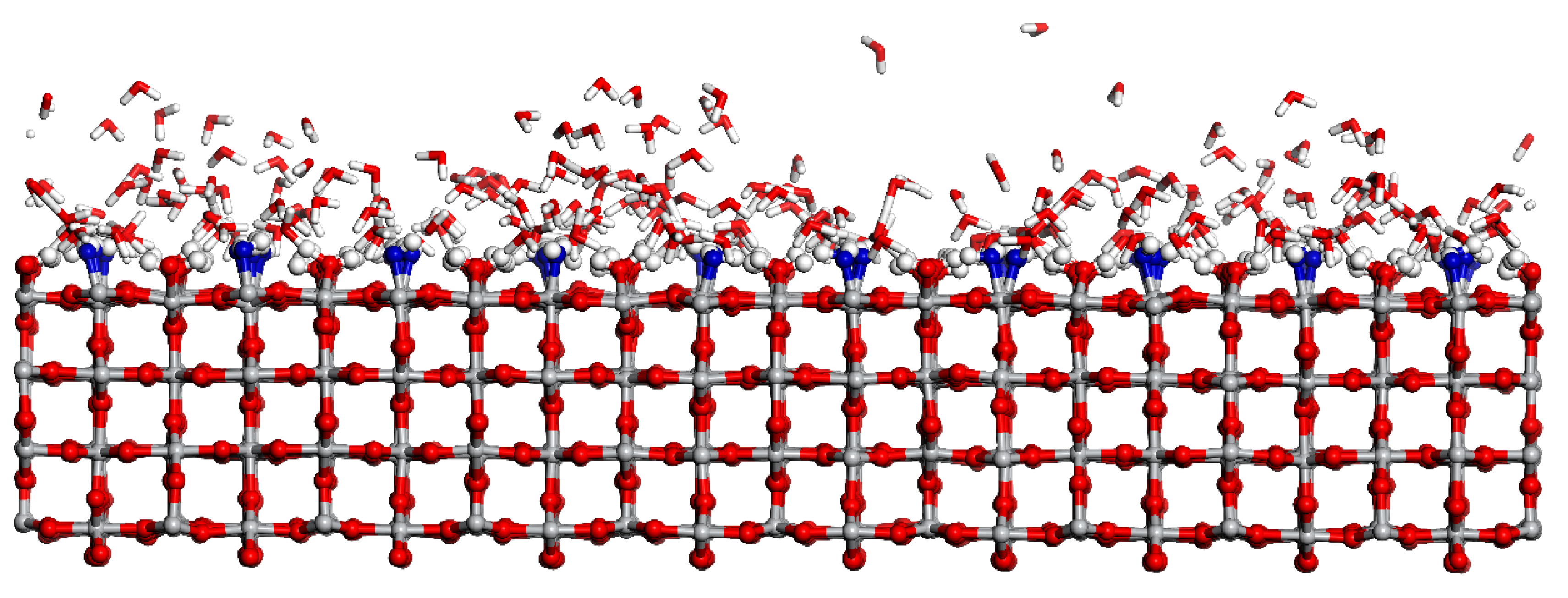


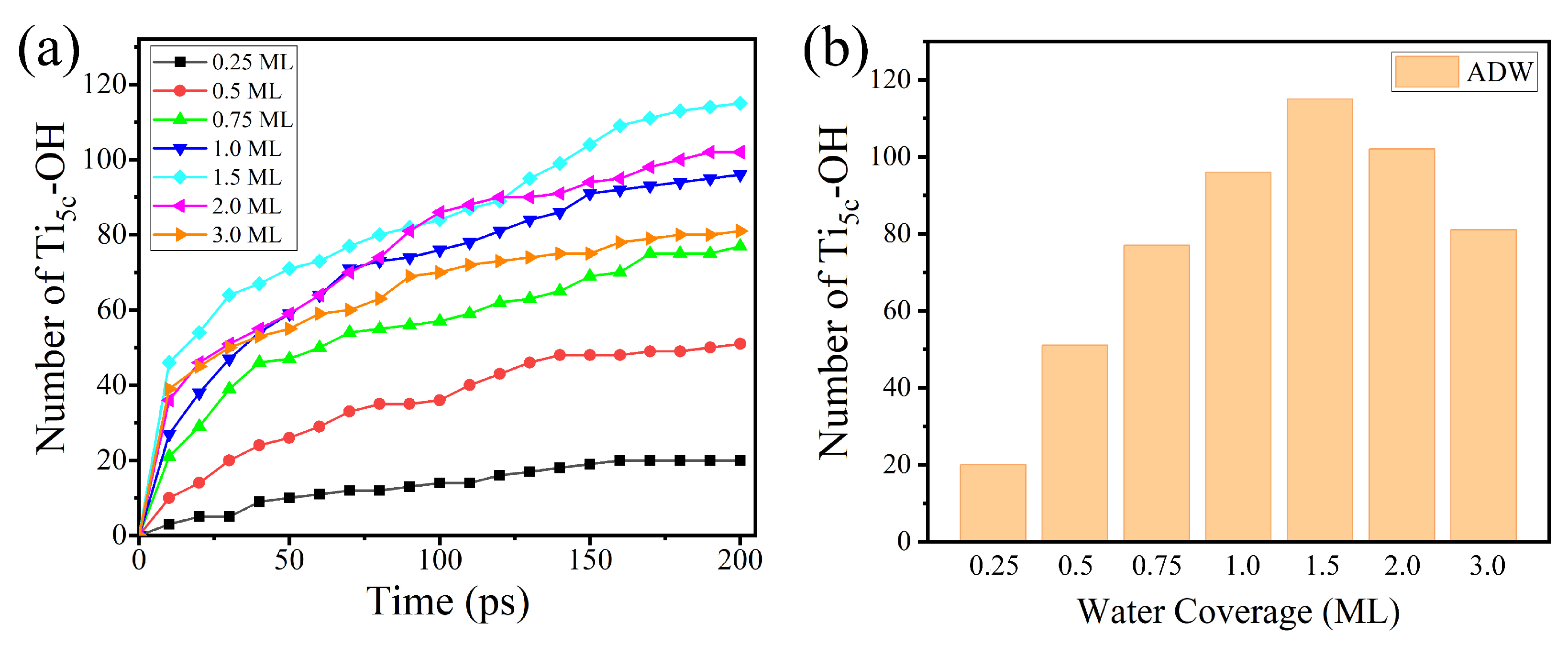
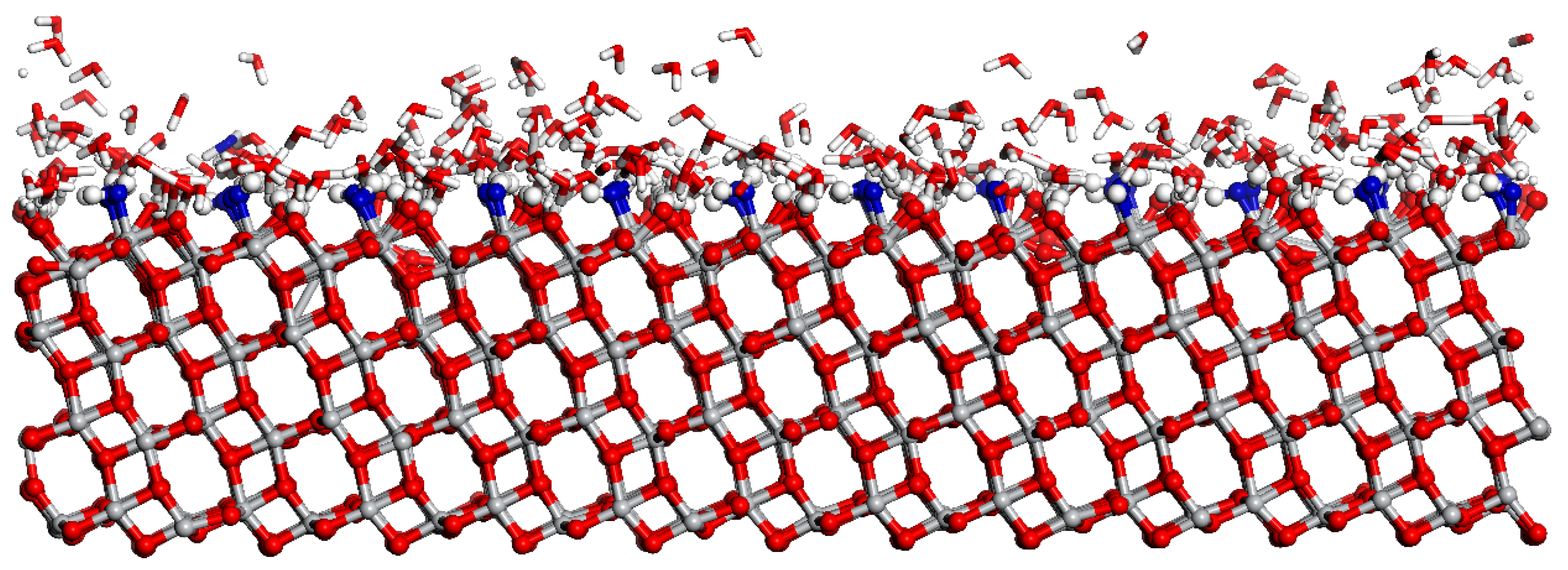
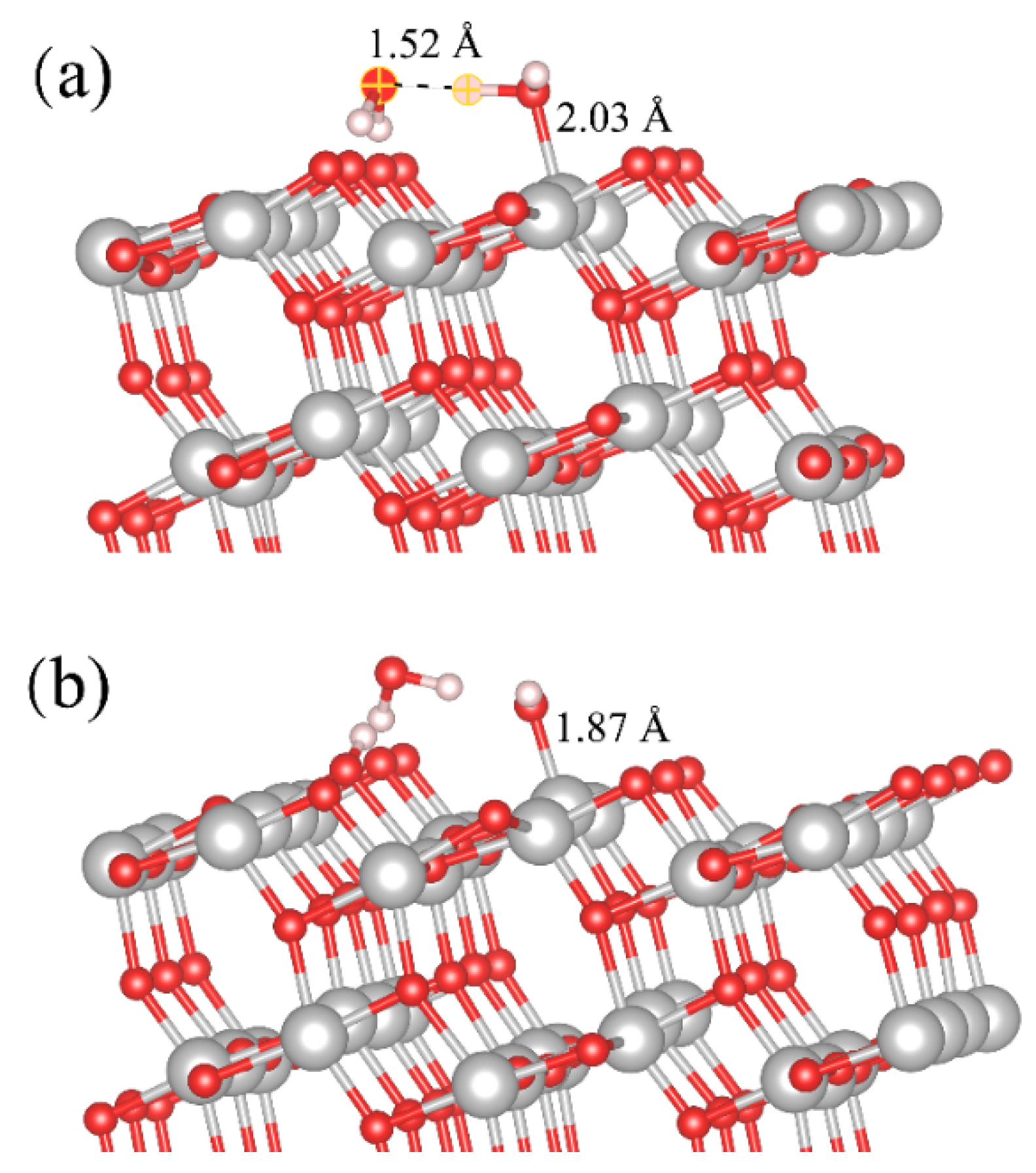

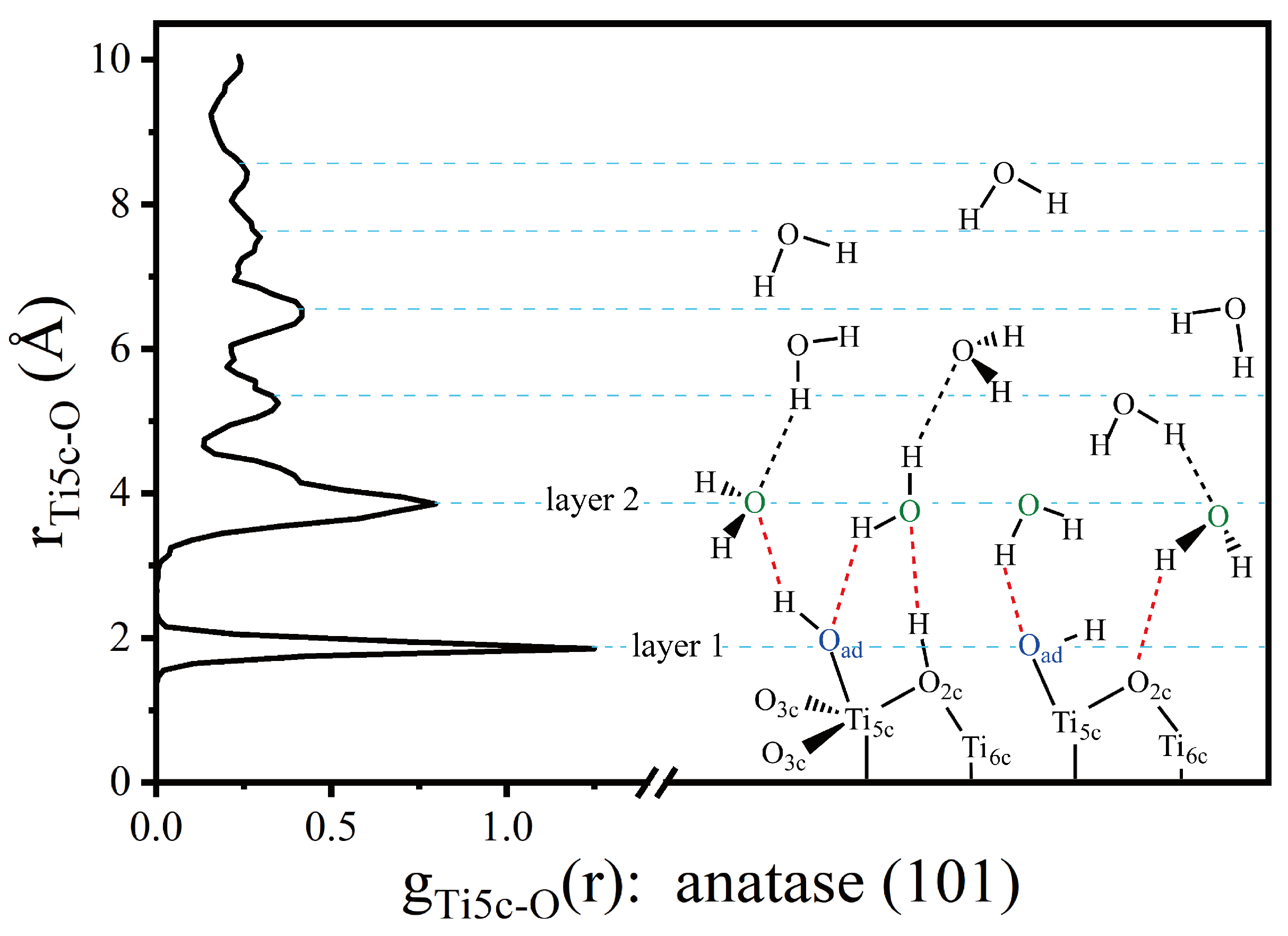
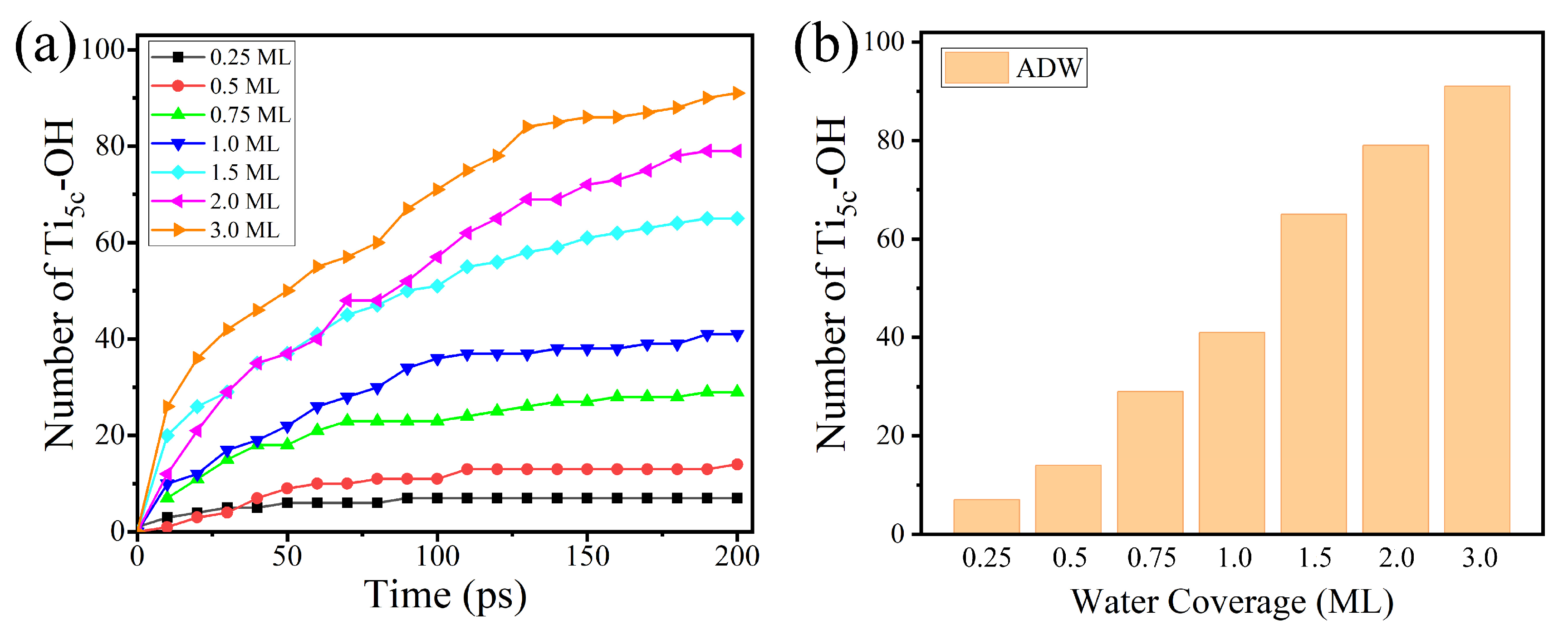
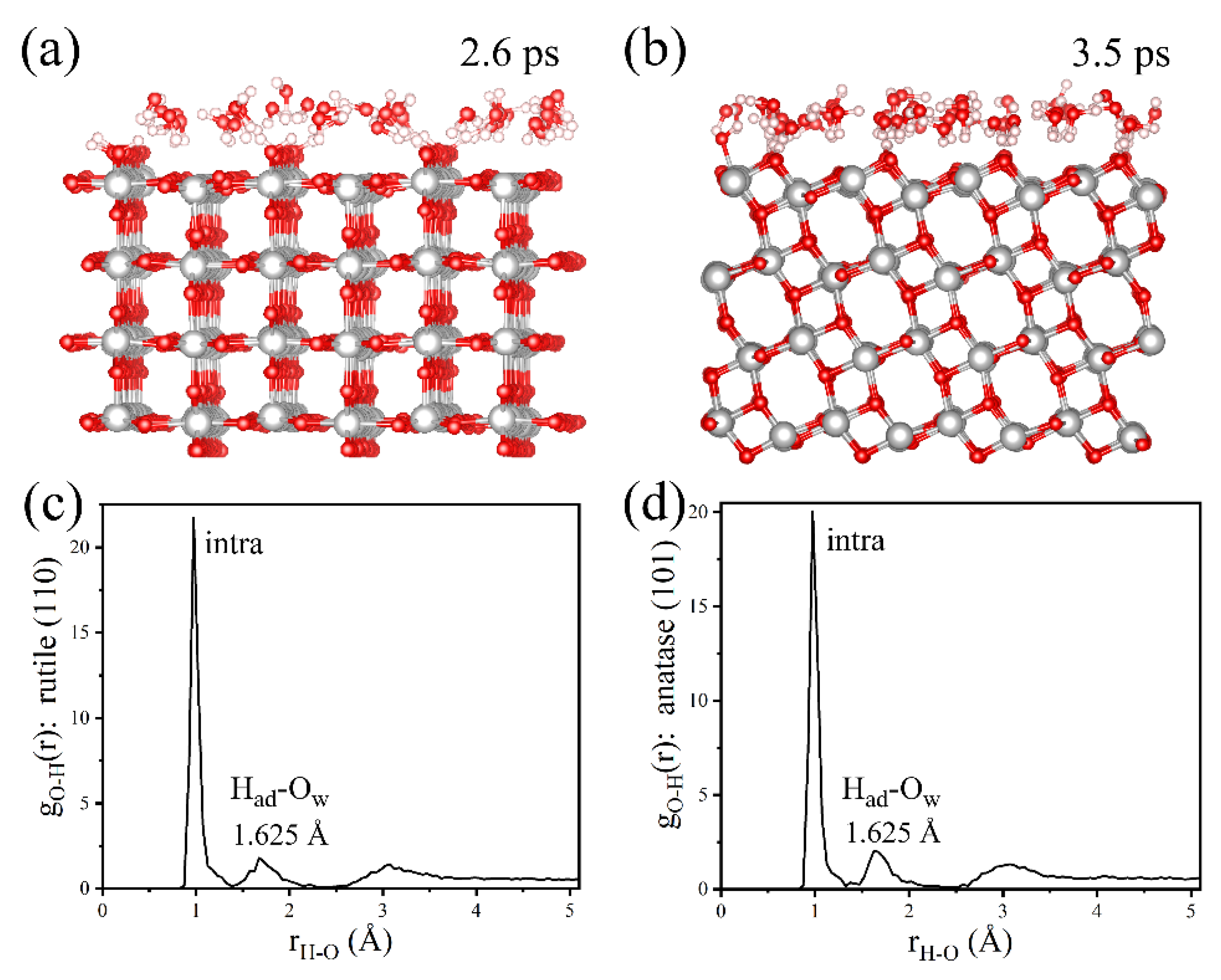
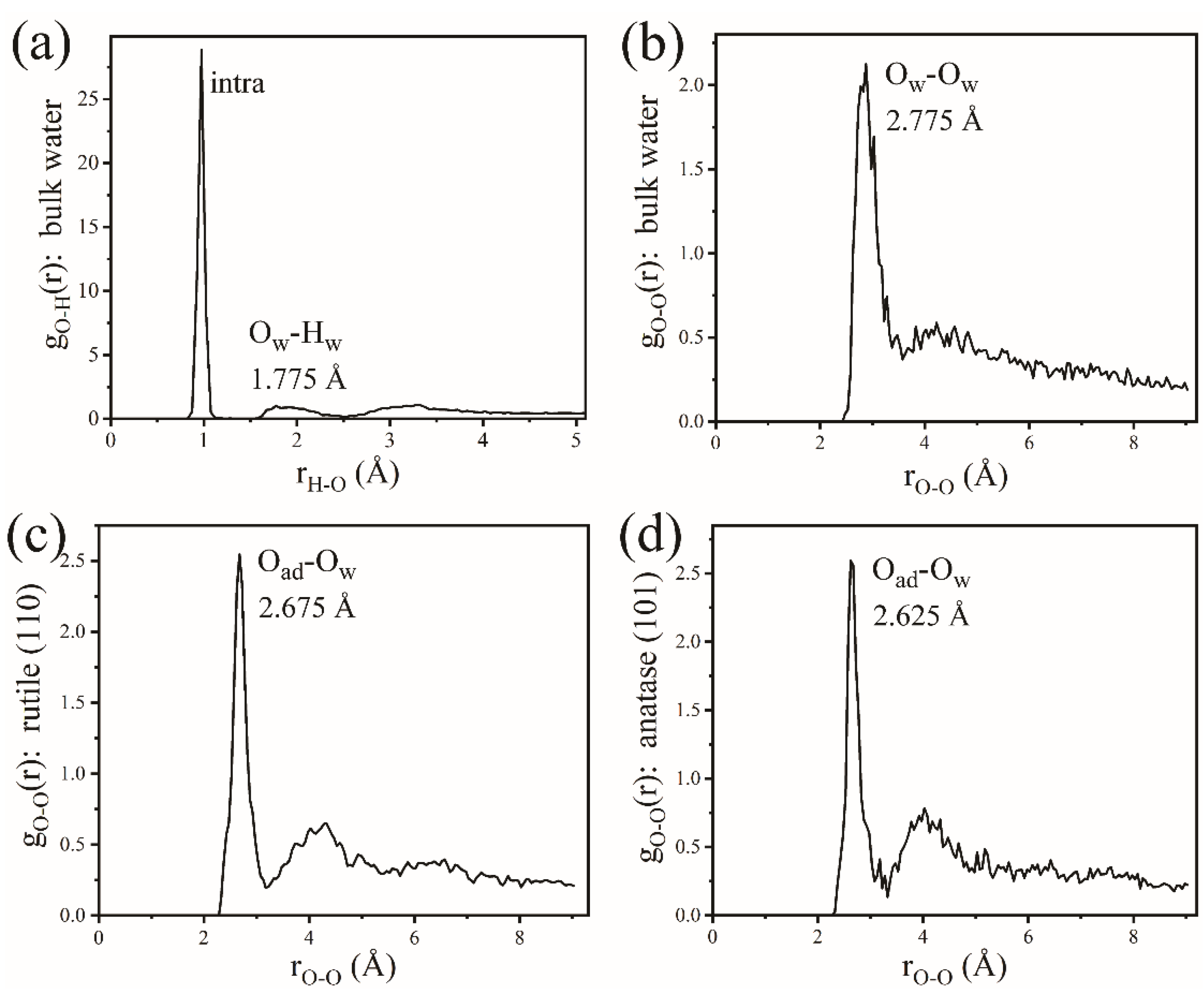


Disclaimer/Publisher’s Note: The statements, opinions and data contained in all publications are solely those of the individual author(s) and contributor(s) and not of MDPI and/or the editor(s). MDPI and/or the editor(s) disclaim responsibility for any injury to people or property resulting from any ideas, methods, instructions or products referred to in the content. |
© 2023 by the authors. Licensee MDPI, Basel, Switzerland. This article is an open access article distributed under the terms and conditions of the Creative Commons Attribution (CC BY) license (https://creativecommons.org/licenses/by/4.0/).
Share and Cite
Zhou, H.; Zhang, H.; Yuan, S. Comparison of H2O Adsorption and Dissociation Behaviors on Rutile (110) and Anatase (101) Surfaces Based on ReaxFF Molecular Dynamics Simulation. Molecules 2023, 28, 6823. https://doi.org/10.3390/molecules28196823
Zhou H, Zhang H, Yuan S. Comparison of H2O Adsorption and Dissociation Behaviors on Rutile (110) and Anatase (101) Surfaces Based on ReaxFF Molecular Dynamics Simulation. Molecules. 2023; 28(19):6823. https://doi.org/10.3390/molecules28196823
Chicago/Turabian StyleZhou, He, Heng Zhang, and Shiling Yuan. 2023. "Comparison of H2O Adsorption and Dissociation Behaviors on Rutile (110) and Anatase (101) Surfaces Based on ReaxFF Molecular Dynamics Simulation" Molecules 28, no. 19: 6823. https://doi.org/10.3390/molecules28196823
APA StyleZhou, H., Zhang, H., & Yuan, S. (2023). Comparison of H2O Adsorption and Dissociation Behaviors on Rutile (110) and Anatase (101) Surfaces Based on ReaxFF Molecular Dynamics Simulation. Molecules, 28(19), 6823. https://doi.org/10.3390/molecules28196823





